Project Management Plan: Improving Employee Training at Nestle
VerifiedAdded on 2020/12/18
|24
|6465
|105
Report
AI Summary
This report delves into project management within multinational corporations, using Nestle as a case study to explore how these companies enhance employee recruitment, selection, and training to align with international standards. The report outlines the aims, objectives, and research questions, providing a comprehensive literature review on globalization and its impact on human resource management. It presents a detailed project management plan, covering costs, scope, time, quality, communication, risk, and resources, along with a work breakdown structure and Gantt chart for project organization. The research employs qualitative and quantitative methods to analyze data and draw meaningful conclusions, offering recommendations based on the findings. The report concludes with a reflection on the research's value and its contribution to meeting the stated objectives. The document highlights Nestle's strategies for adapting to global market demands, emphasizing the importance of employee skills and training in meeting international requirements.
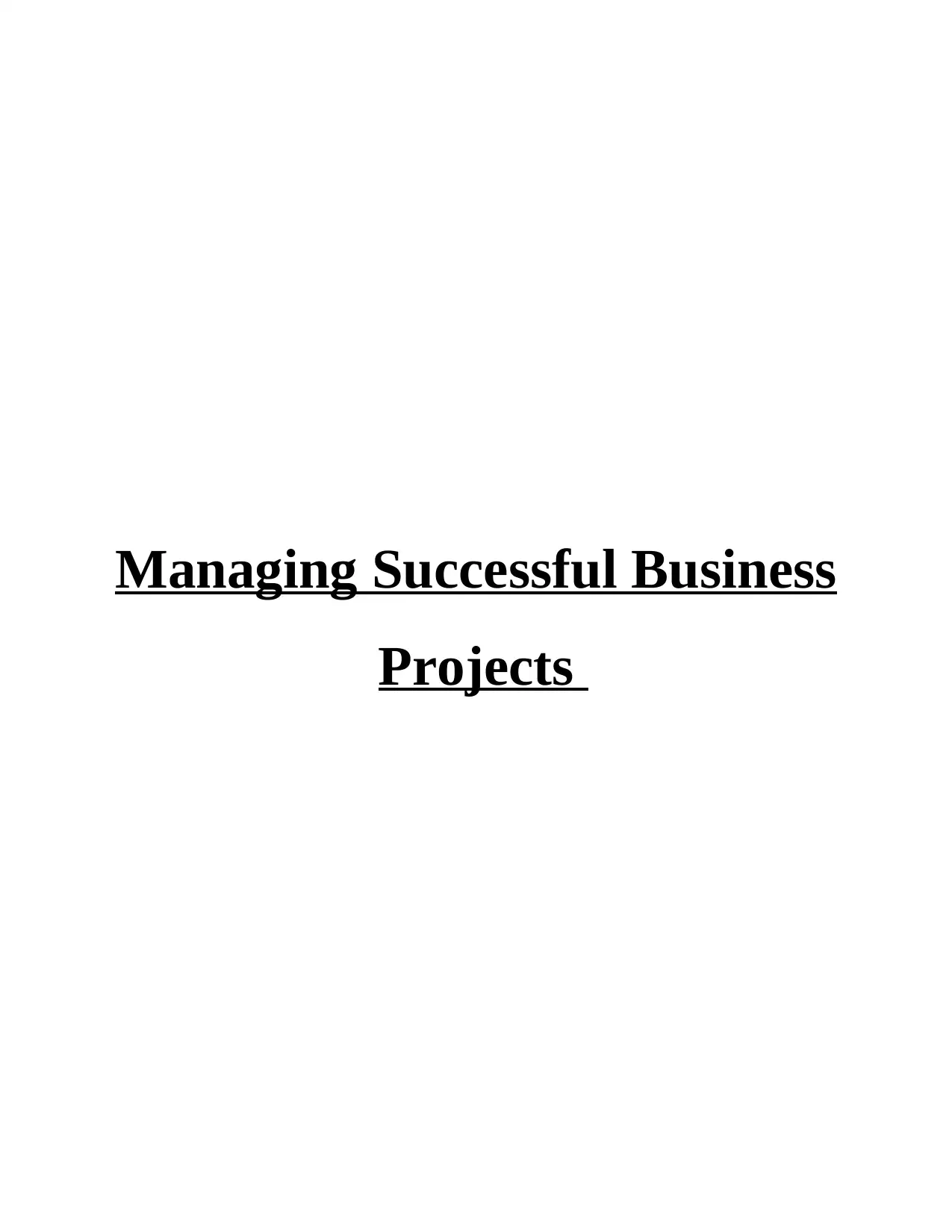
Managing Successful Business
Projects
Projects
Paraphrase This Document
Need a fresh take? Get an instant paraphrase of this document with our AI Paraphraser
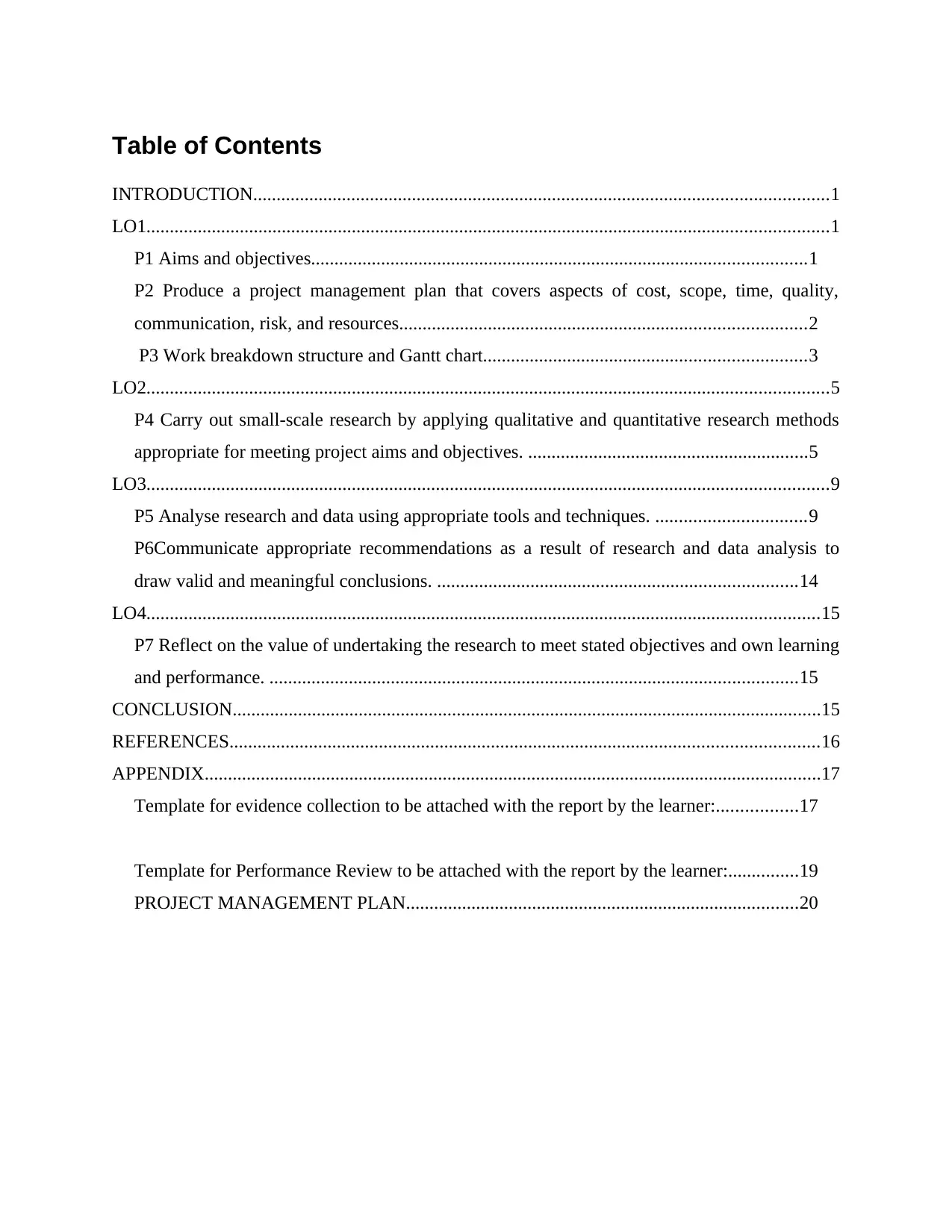
Table of Contents
INTRODUCTION...........................................................................................................................1
LO1..................................................................................................................................................1
P1 Aims and objectives..........................................................................................................1
P2 Produce a project management plan that covers aspects of cost, scope, time, quality,
communication, risk, and resources.......................................................................................2
P3 Work breakdown structure and Gantt chart.....................................................................3
LO2..................................................................................................................................................5
P4 Carry out small-scale research by applying qualitative and quantitative research methods
appropriate for meeting project aims and objectives. ............................................................5
LO3..................................................................................................................................................9
P5 Analyse research and data using appropriate tools and techniques. ................................9
P6Communicate appropriate recommendations as a result of research and data analysis to
draw valid and meaningful conclusions. .............................................................................14
LO4................................................................................................................................................15
P7 Reflect on the value of undertaking the research to meet stated objectives and own learning
and performance. .................................................................................................................15
CONCLUSION..............................................................................................................................15
REFERENCES..............................................................................................................................16
APPENDIX....................................................................................................................................17
Template for evidence collection to be attached with the report by the learner:.................17
Template for Performance Review to be attached with the report by the learner:...............19
PROJECT MANAGEMENT PLAN....................................................................................20
INTRODUCTION...........................................................................................................................1
LO1..................................................................................................................................................1
P1 Aims and objectives..........................................................................................................1
P2 Produce a project management plan that covers aspects of cost, scope, time, quality,
communication, risk, and resources.......................................................................................2
P3 Work breakdown structure and Gantt chart.....................................................................3
LO2..................................................................................................................................................5
P4 Carry out small-scale research by applying qualitative and quantitative research methods
appropriate for meeting project aims and objectives. ............................................................5
LO3..................................................................................................................................................9
P5 Analyse research and data using appropriate tools and techniques. ................................9
P6Communicate appropriate recommendations as a result of research and data analysis to
draw valid and meaningful conclusions. .............................................................................14
LO4................................................................................................................................................15
P7 Reflect on the value of undertaking the research to meet stated objectives and own learning
and performance. .................................................................................................................15
CONCLUSION..............................................................................................................................15
REFERENCES..............................................................................................................................16
APPENDIX....................................................................................................................................17
Template for evidence collection to be attached with the report by the learner:.................17
Template for Performance Review to be attached with the report by the learner:...............19
PROJECT MANAGEMENT PLAN....................................................................................20
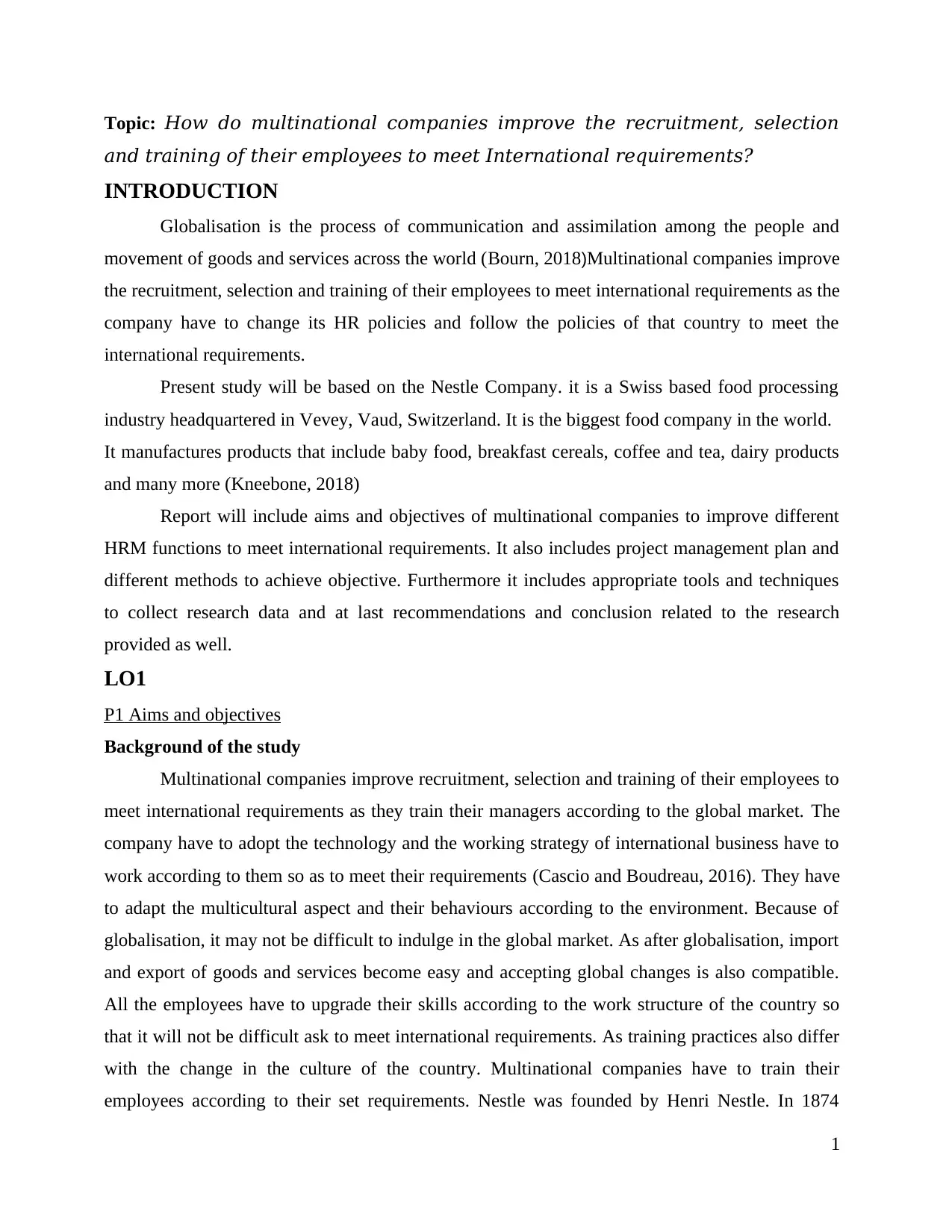
Topic: How do multinational companies improve the recruitment, selection
and training of their employees to meet International requirements?
INTRODUCTION
Globalisation is the process of communication and assimilation among the people and
movement of goods and services across the world (Bourn, 2018)Multinational companies improve
the recruitment, selection and training of their employees to meet international requirements as the
company have to change its HR policies and follow the policies of that country to meet the
international requirements.
Present study will be based on the Nestle Company. it is a Swiss based food processing
industry headquartered in Vevey, Vaud, Switzerland. It is the biggest food company in the world.
It manufactures products that include baby food, breakfast cereals, coffee and tea, dairy products
and many more (Kneebone, 2018)
Report will include aims and objectives of multinational companies to improve different
HRM functions to meet international requirements. It also includes project management plan and
different methods to achieve objective. Furthermore it includes appropriate tools and techniques
to collect research data and at last recommendations and conclusion related to the research
provided as well.
LO1
P1 Aims and objectives
Background of the study
Multinational companies improve recruitment, selection and training of their employees to
meet international requirements as they train their managers according to the global market. The
company have to adopt the technology and the working strategy of international business have to
work according to them so as to meet their requirements (Cascio and Boudreau, 2016). They have
to adapt the multicultural aspect and their behaviours according to the environment. Because of
globalisation, it may not be difficult to indulge in the global market. As after globalisation, import
and export of goods and services become easy and accepting global changes is also compatible.
All the employees have to upgrade their skills according to the work structure of the country so
that it will not be difficult ask to meet international requirements. As training practices also differ
with the change in the culture of the country. Multinational companies have to train their
employees according to their set requirements. Nestle was founded by Henri Nestle. In 1874
1
and training of their employees to meet International requirements?
INTRODUCTION
Globalisation is the process of communication and assimilation among the people and
movement of goods and services across the world (Bourn, 2018)Multinational companies improve
the recruitment, selection and training of their employees to meet international requirements as the
company have to change its HR policies and follow the policies of that country to meet the
international requirements.
Present study will be based on the Nestle Company. it is a Swiss based food processing
industry headquartered in Vevey, Vaud, Switzerland. It is the biggest food company in the world.
It manufactures products that include baby food, breakfast cereals, coffee and tea, dairy products
and many more (Kneebone, 2018)
Report will include aims and objectives of multinational companies to improve different
HRM functions to meet international requirements. It also includes project management plan and
different methods to achieve objective. Furthermore it includes appropriate tools and techniques
to collect research data and at last recommendations and conclusion related to the research
provided as well.
LO1
P1 Aims and objectives
Background of the study
Multinational companies improve recruitment, selection and training of their employees to
meet international requirements as they train their managers according to the global market. The
company have to adopt the technology and the working strategy of international business have to
work according to them so as to meet their requirements (Cascio and Boudreau, 2016). They have
to adapt the multicultural aspect and their behaviours according to the environment. Because of
globalisation, it may not be difficult to indulge in the global market. As after globalisation, import
and export of goods and services become easy and accepting global changes is also compatible.
All the employees have to upgrade their skills according to the work structure of the country so
that it will not be difficult ask to meet international requirements. As training practices also differ
with the change in the culture of the country. Multinational companies have to train their
employees according to their set requirements. Nestle was founded by Henri Nestle. In 1874
1
⊘ This is a preview!⊘
Do you want full access?
Subscribe today to unlock all pages.

Trusted by 1+ million students worldwide
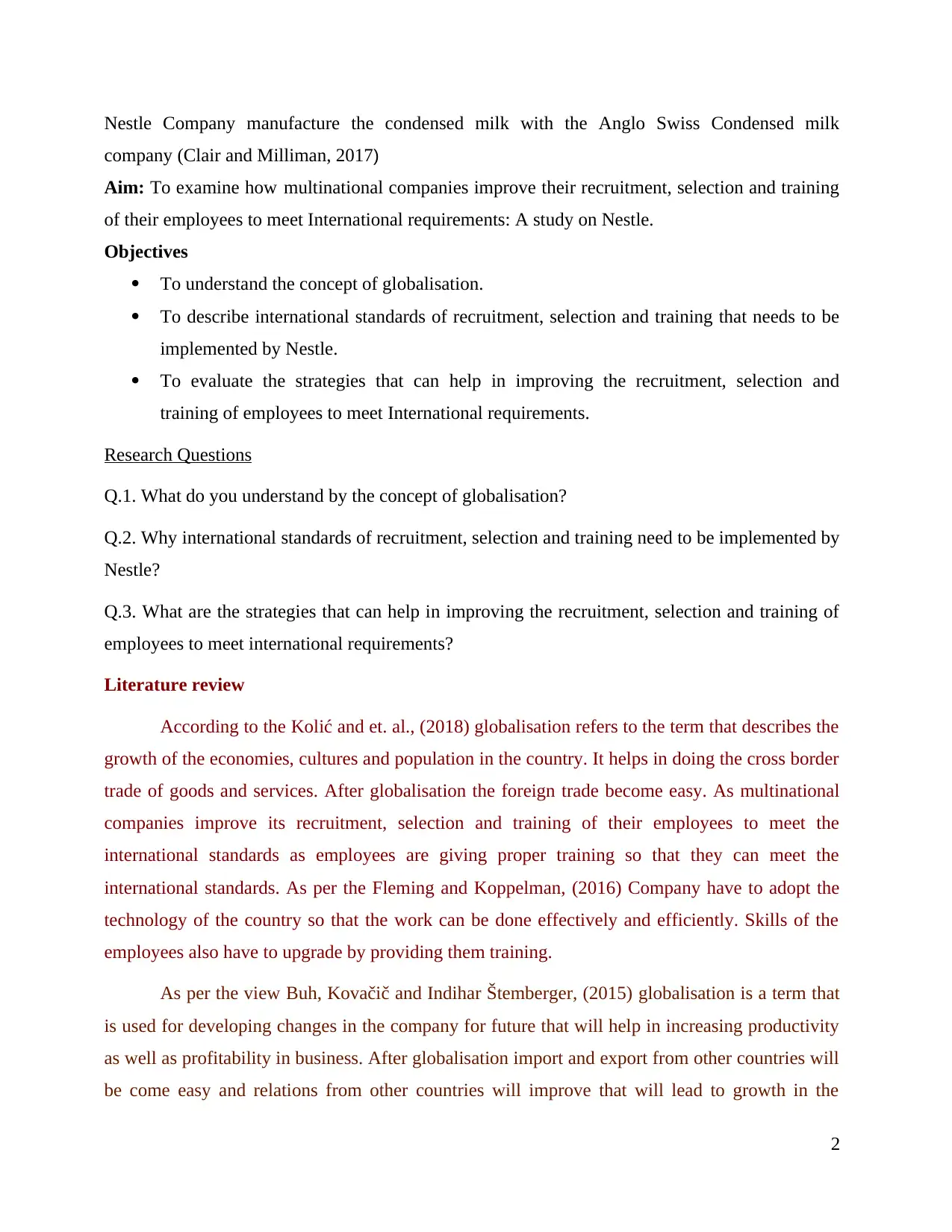
Nestle Company manufacture the condensed milk with the Anglo Swiss Condensed milk
company (Clair and Milliman, 2017)
Aim: To examine how multinational companies improve their recruitment, selection and training
of their employees to meet International requirements: A study on Nestle.
Objectives
To understand the concept of globalisation.
To describe international standards of recruitment, selection and training that needs to be
implemented by Nestle.
To evaluate the strategies that can help in improving the recruitment, selection and
training of employees to meet International requirements.
Research Questions
Q.1. What do you understand by the concept of globalisation?
Q.2. Why international standards of recruitment, selection and training need to be implemented by
Nestle?
Q.3. What are the strategies that can help in improving the recruitment, selection and training of
employees to meet international requirements?
Literature review
According to the Kolić and et. al., (2018) globalisation refers to the term that describes the
growth of the economies, cultures and population in the country. It helps in doing the cross border
trade of goods and services. After globalisation the foreign trade become easy. As multinational
companies improve its recruitment, selection and training of their employees to meet the
international standards as employees are giving proper training so that they can meet the
international standards. As per the Fleming and Koppelman, (2016) Company have to adopt the
technology of the country so that the work can be done effectively and efficiently. Skills of the
employees also have to upgrade by providing them training.
As per the view Buh, Kovačič and Indihar Štemberger, (2015) globalisation is a term that
is used for developing changes in the company for future that will help in increasing productivity
as well as profitability in business. After globalisation import and export from other countries will
be come easy and relations from other countries will improve that will lead to growth in the
2
company (Clair and Milliman, 2017)
Aim: To examine how multinational companies improve their recruitment, selection and training
of their employees to meet International requirements: A study on Nestle.
Objectives
To understand the concept of globalisation.
To describe international standards of recruitment, selection and training that needs to be
implemented by Nestle.
To evaluate the strategies that can help in improving the recruitment, selection and
training of employees to meet International requirements.
Research Questions
Q.1. What do you understand by the concept of globalisation?
Q.2. Why international standards of recruitment, selection and training need to be implemented by
Nestle?
Q.3. What are the strategies that can help in improving the recruitment, selection and training of
employees to meet international requirements?
Literature review
According to the Kolić and et. al., (2018) globalisation refers to the term that describes the
growth of the economies, cultures and population in the country. It helps in doing the cross border
trade of goods and services. After globalisation the foreign trade become easy. As multinational
companies improve its recruitment, selection and training of their employees to meet the
international standards as employees are giving proper training so that they can meet the
international standards. As per the Fleming and Koppelman, (2016) Company have to adopt the
technology of the country so that the work can be done effectively and efficiently. Skills of the
employees also have to upgrade by providing them training.
As per the view Buh, Kovačič and Indihar Štemberger, (2015) globalisation is a term that
is used for developing changes in the company for future that will help in increasing productivity
as well as profitability in business. After globalisation import and export from other countries will
be come easy and relations from other countries will improve that will lead to growth in the
2
Paraphrase This Document
Need a fresh take? Get an instant paraphrase of this document with our AI Paraphraser
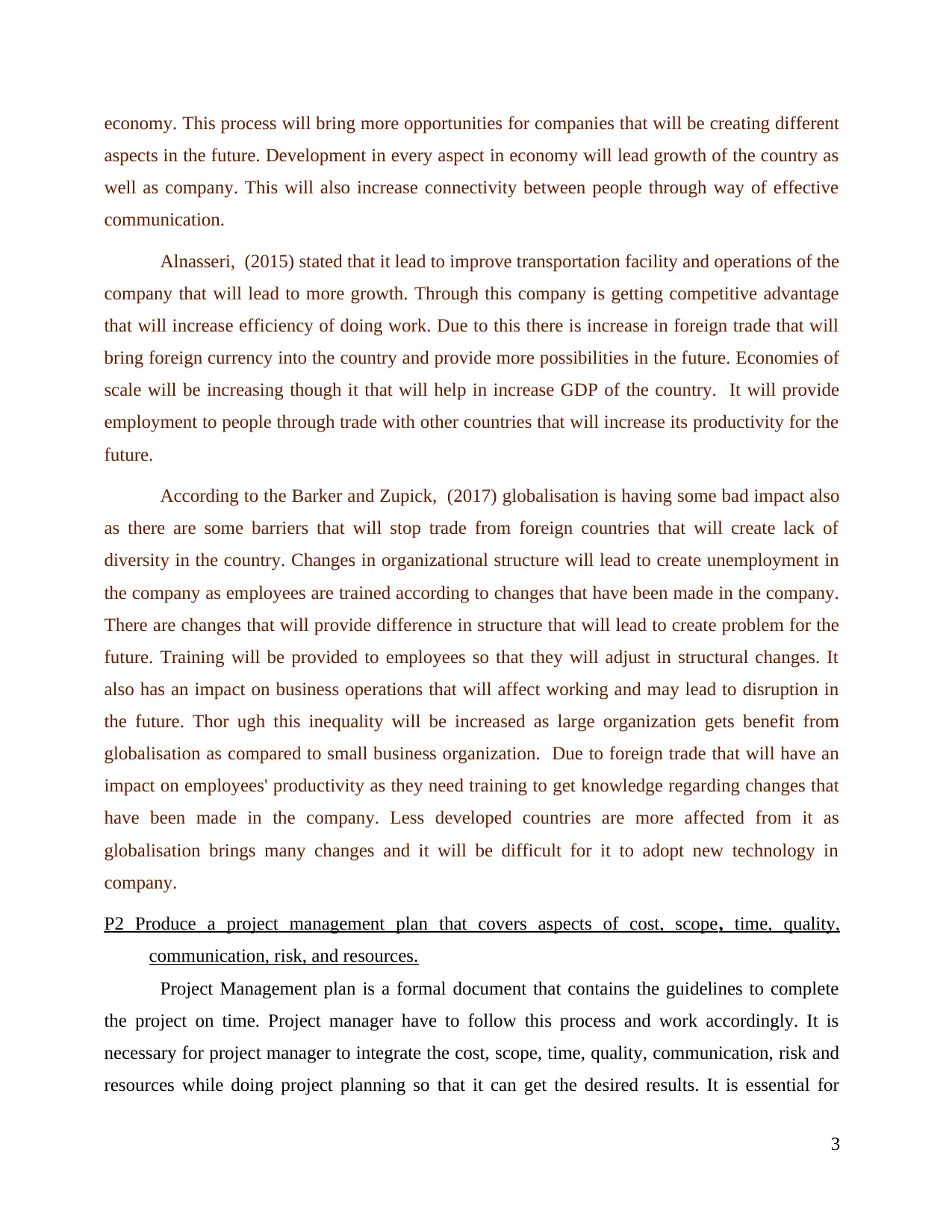
economy. This process will bring more opportunities for companies that will be creating different
aspects in the future. Development in every aspect in economy will lead growth of the country as
well as company. This will also increase connectivity between people through way of effective
communication.
Alnasseri, (2015) stated that it lead to improve transportation facility and operations of the
company that will lead to more growth. Through this company is getting competitive advantage
that will increase efficiency of doing work. Due to this there is increase in foreign trade that will
bring foreign currency into the country and provide more possibilities in the future. Economies of
scale will be increasing though it that will help in increase GDP of the country. It will provide
employment to people through trade with other countries that will increase its productivity for the
future.
According to the Barker and Zupick, (2017) globalisation is having some bad impact also
as there are some barriers that will stop trade from foreign countries that will create lack of
diversity in the country. Changes in organizational structure will lead to create unemployment in
the company as employees are trained according to changes that have been made in the company.
There are changes that will provide difference in structure that will lead to create problem for the
future. Training will be provided to employees so that they will adjust in structural changes. It
also has an impact on business operations that will affect working and may lead to disruption in
the future. Thor ugh this inequality will be increased as large organization gets benefit from
globalisation as compared to small business organization. Due to foreign trade that will have an
impact on employees' productivity as they need training to get knowledge regarding changes that
have been made in the company. Less developed countries are more affected from it as
globalisation brings many changes and it will be difficult for it to adopt new technology in
company.
P2 Produce a project management plan that covers aspects of cost, scope, time, quality,
communication, risk, and resources.
Project Management plan is a formal document that contains the guidelines to complete
the project on time. Project manager have to follow this process and work accordingly. It is
necessary for project manager to integrate the cost, scope, time, quality, communication, risk and
resources while doing project planning so that it can get the desired results. It is essential for
3
aspects in the future. Development in every aspect in economy will lead growth of the country as
well as company. This will also increase connectivity between people through way of effective
communication.
Alnasseri, (2015) stated that it lead to improve transportation facility and operations of the
company that will lead to more growth. Through this company is getting competitive advantage
that will increase efficiency of doing work. Due to this there is increase in foreign trade that will
bring foreign currency into the country and provide more possibilities in the future. Economies of
scale will be increasing though it that will help in increase GDP of the country. It will provide
employment to people through trade with other countries that will increase its productivity for the
future.
According to the Barker and Zupick, (2017) globalisation is having some bad impact also
as there are some barriers that will stop trade from foreign countries that will create lack of
diversity in the country. Changes in organizational structure will lead to create unemployment in
the company as employees are trained according to changes that have been made in the company.
There are changes that will provide difference in structure that will lead to create problem for the
future. Training will be provided to employees so that they will adjust in structural changes. It
also has an impact on business operations that will affect working and may lead to disruption in
the future. Thor ugh this inequality will be increased as large organization gets benefit from
globalisation as compared to small business organization. Due to foreign trade that will have an
impact on employees' productivity as they need training to get knowledge regarding changes that
have been made in the company. Less developed countries are more affected from it as
globalisation brings many changes and it will be difficult for it to adopt new technology in
company.
P2 Produce a project management plan that covers aspects of cost, scope, time, quality,
communication, risk, and resources.
Project Management plan is a formal document that contains the guidelines to complete
the project on time. Project manager have to follow this process and work accordingly. It is
necessary for project manager to integrate the cost, scope, time, quality, communication, risk and
resources while doing project planning so that it can get the desired results. It is essential for
3
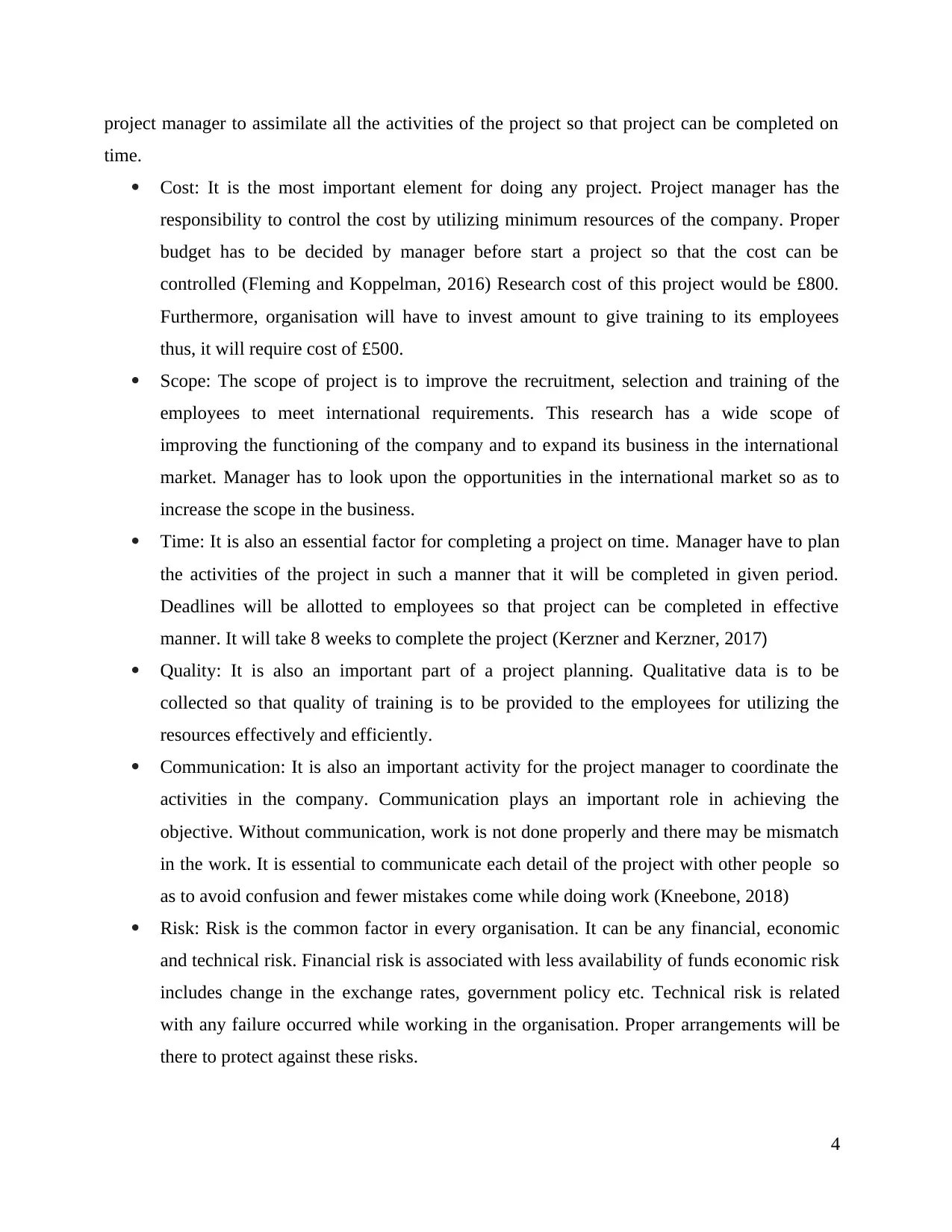
project manager to assimilate all the activities of the project so that project can be completed on
time.
Cost: It is the most important element for doing any project. Project manager has the
responsibility to control the cost by utilizing minimum resources of the company. Proper
budget has to be decided by manager before start a project so that the cost can be
controlled (Fleming and Koppelman, 2016) Research cost of this project would be £800.
Furthermore, organisation will have to invest amount to give training to its employees
thus, it will require cost of £500.
Scope: The scope of project is to improve the recruitment, selection and training of the
employees to meet international requirements. This research has a wide scope of
improving the functioning of the company and to expand its business in the international
market. Manager has to look upon the opportunities in the international market so as to
increase the scope in the business.
Time: It is also an essential factor for completing a project on time. Manager have to plan
the activities of the project in such a manner that it will be completed in given period.
Deadlines will be allotted to employees so that project can be completed in effective
manner. It will take 8 weeks to complete the project (Kerzner and Kerzner, 2017)
Quality: It is also an important part of a project planning. Qualitative data is to be
collected so that quality of training is to be provided to the employees for utilizing the
resources effectively and efficiently.
Communication: It is also an important activity for the project manager to coordinate the
activities in the company. Communication plays an important role in achieving the
objective. Without communication, work is not done properly and there may be mismatch
in the work. It is essential to communicate each detail of the project with other people so
as to avoid confusion and fewer mistakes come while doing work (Kneebone, 2018)
Risk: Risk is the common factor in every organisation. It can be any financial, economic
and technical risk. Financial risk is associated with less availability of funds economic risk
includes change in the exchange rates, government policy etc. Technical risk is related
with any failure occurred while working in the organisation. Proper arrangements will be
there to protect against these risks.
4
time.
Cost: It is the most important element for doing any project. Project manager has the
responsibility to control the cost by utilizing minimum resources of the company. Proper
budget has to be decided by manager before start a project so that the cost can be
controlled (Fleming and Koppelman, 2016) Research cost of this project would be £800.
Furthermore, organisation will have to invest amount to give training to its employees
thus, it will require cost of £500.
Scope: The scope of project is to improve the recruitment, selection and training of the
employees to meet international requirements. This research has a wide scope of
improving the functioning of the company and to expand its business in the international
market. Manager has to look upon the opportunities in the international market so as to
increase the scope in the business.
Time: It is also an essential factor for completing a project on time. Manager have to plan
the activities of the project in such a manner that it will be completed in given period.
Deadlines will be allotted to employees so that project can be completed in effective
manner. It will take 8 weeks to complete the project (Kerzner and Kerzner, 2017)
Quality: It is also an important part of a project planning. Qualitative data is to be
collected so that quality of training is to be provided to the employees for utilizing the
resources effectively and efficiently.
Communication: It is also an important activity for the project manager to coordinate the
activities in the company. Communication plays an important role in achieving the
objective. Without communication, work is not done properly and there may be mismatch
in the work. It is essential to communicate each detail of the project with other people so
as to avoid confusion and fewer mistakes come while doing work (Kneebone, 2018)
Risk: Risk is the common factor in every organisation. It can be any financial, economic
and technical risk. Financial risk is associated with less availability of funds economic risk
includes change in the exchange rates, government policy etc. Technical risk is related
with any failure occurred while working in the organisation. Proper arrangements will be
there to protect against these risks.
4
⊘ This is a preview!⊘
Do you want full access?
Subscribe today to unlock all pages.

Trusted by 1+ million students worldwide
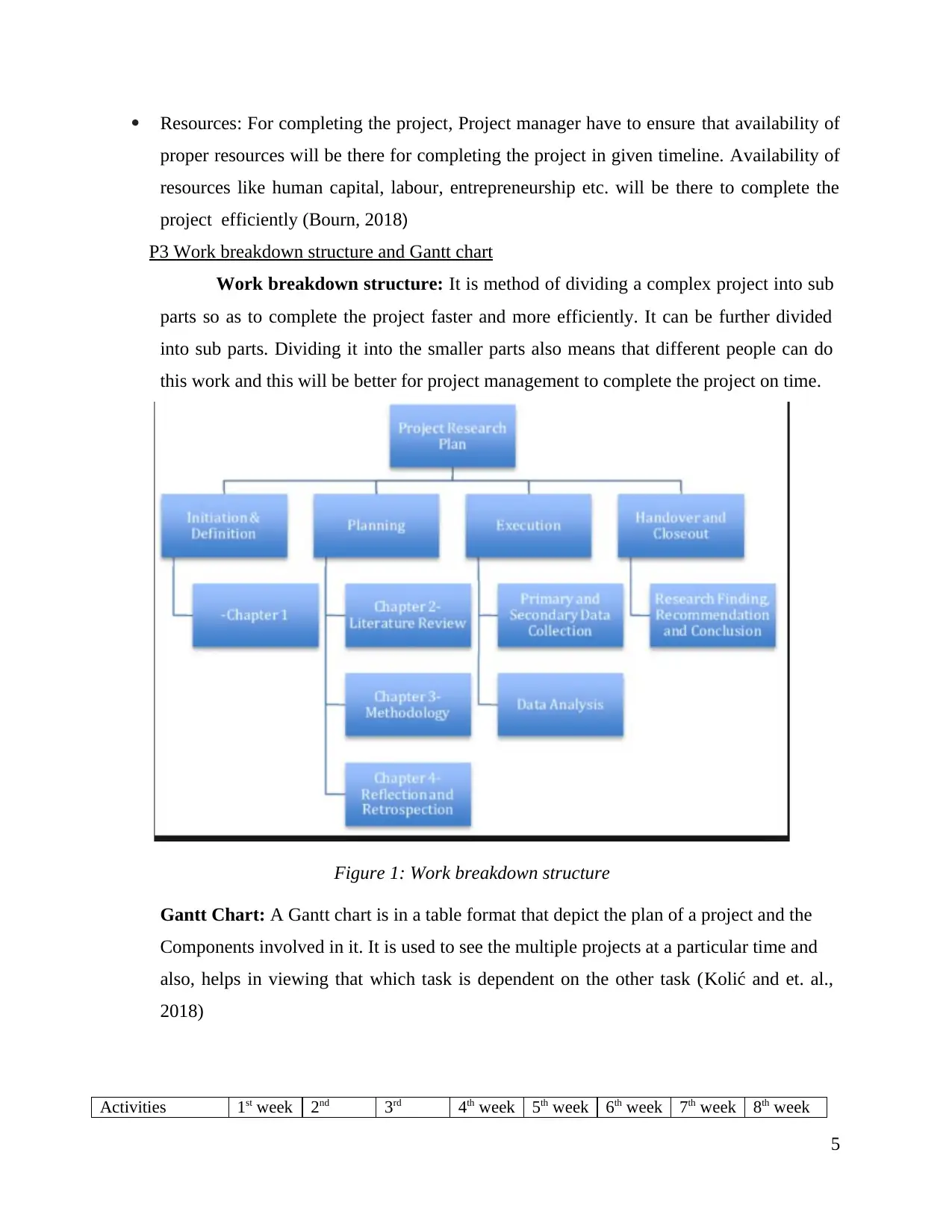
Resources: For completing the project, Project manager have to ensure that availability of
proper resources will be there for completing the project in given timeline. Availability of
resources like human capital, labour, entrepreneurship etc. will be there to complete the
project efficiently (Bourn, 2018)
P3 Work breakdown structure and Gantt chart
Work breakdown structure: It is method of dividing a complex project into sub
parts so as to complete the project faster and more efficiently. It can be further divided
into sub parts. Dividing it into the smaller parts also means that different people can do
this work and this will be better for project management to complete the project on time.
Figure 1: Work breakdown structure
Gantt Chart: A Gantt chart is in a table format that depict the plan of a project and the
Components involved in it. It is used to see the multiple projects at a particular time and
also, helps in viewing that which task is dependent on the other task (Kolić and et. al.,
2018)
Activities 1st week 2nd 3rd 4th week 5th week 6th week 7th week 8th week
5
proper resources will be there for completing the project in given timeline. Availability of
resources like human capital, labour, entrepreneurship etc. will be there to complete the
project efficiently (Bourn, 2018)
P3 Work breakdown structure and Gantt chart
Work breakdown structure: It is method of dividing a complex project into sub
parts so as to complete the project faster and more efficiently. It can be further divided
into sub parts. Dividing it into the smaller parts also means that different people can do
this work and this will be better for project management to complete the project on time.
Figure 1: Work breakdown structure
Gantt Chart: A Gantt chart is in a table format that depict the plan of a project and the
Components involved in it. It is used to see the multiple projects at a particular time and
also, helps in viewing that which task is dependent on the other task (Kolić and et. al.,
2018)
Activities 1st week 2nd 3rd 4th week 5th week 6th week 7th week 8th week
5
Paraphrase This Document
Need a fresh take? Get an instant paraphrase of this document with our AI Paraphraser
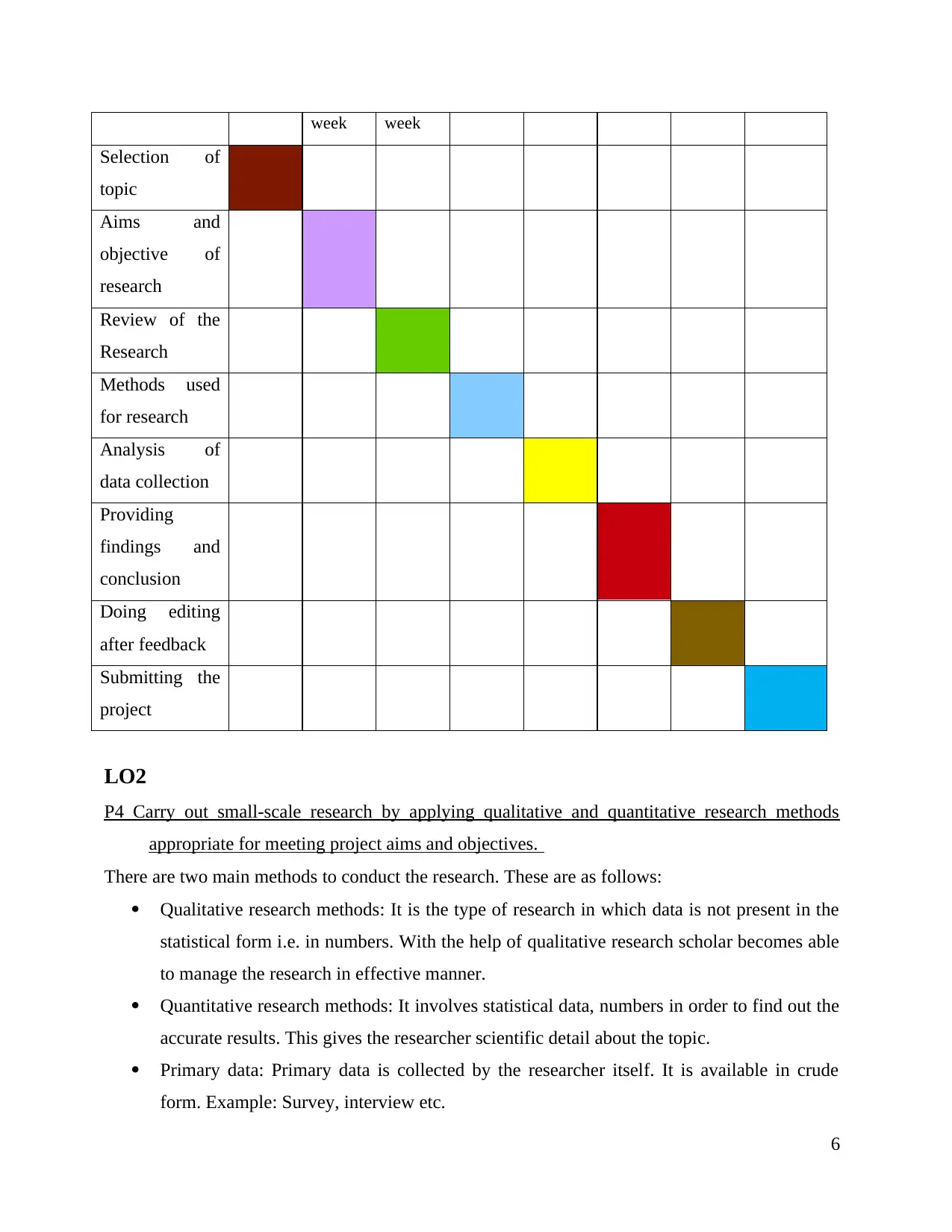
week week
Selection of
topic
Aims and
objective of
research
Review of the
Research
Methods used
for research
Analysis of
data collection
Providing
findings and
conclusion
Doing editing
after feedback
Submitting the
project
LO2
P4 Carry out small-scale research by applying qualitative and quantitative research methods
appropriate for meeting project aims and objectives.
There are two main methods to conduct the research. These are as follows:
Qualitative research methods: It is the type of research in which data is not present in the
statistical form i.e. in numbers. With the help of qualitative research scholar becomes able
to manage the research in effective manner.
Quantitative research methods: It involves statistical data, numbers in order to find out the
accurate results. This gives the researcher scientific detail about the topic.
Primary data: Primary data is collected by the researcher itself. It is available in crude
form. Example: Survey, interview etc.
6
Selection of
topic
Aims and
objective of
research
Review of the
Research
Methods used
for research
Analysis of
data collection
Providing
findings and
conclusion
Doing editing
after feedback
Submitting the
project
LO2
P4 Carry out small-scale research by applying qualitative and quantitative research methods
appropriate for meeting project aims and objectives.
There are two main methods to conduct the research. These are as follows:
Qualitative research methods: It is the type of research in which data is not present in the
statistical form i.e. in numbers. With the help of qualitative research scholar becomes able
to manage the research in effective manner.
Quantitative research methods: It involves statistical data, numbers in order to find out the
accurate results. This gives the researcher scientific detail about the topic.
Primary data: Primary data is collected by the researcher itself. It is available in crude
form. Example: Survey, interview etc.
6
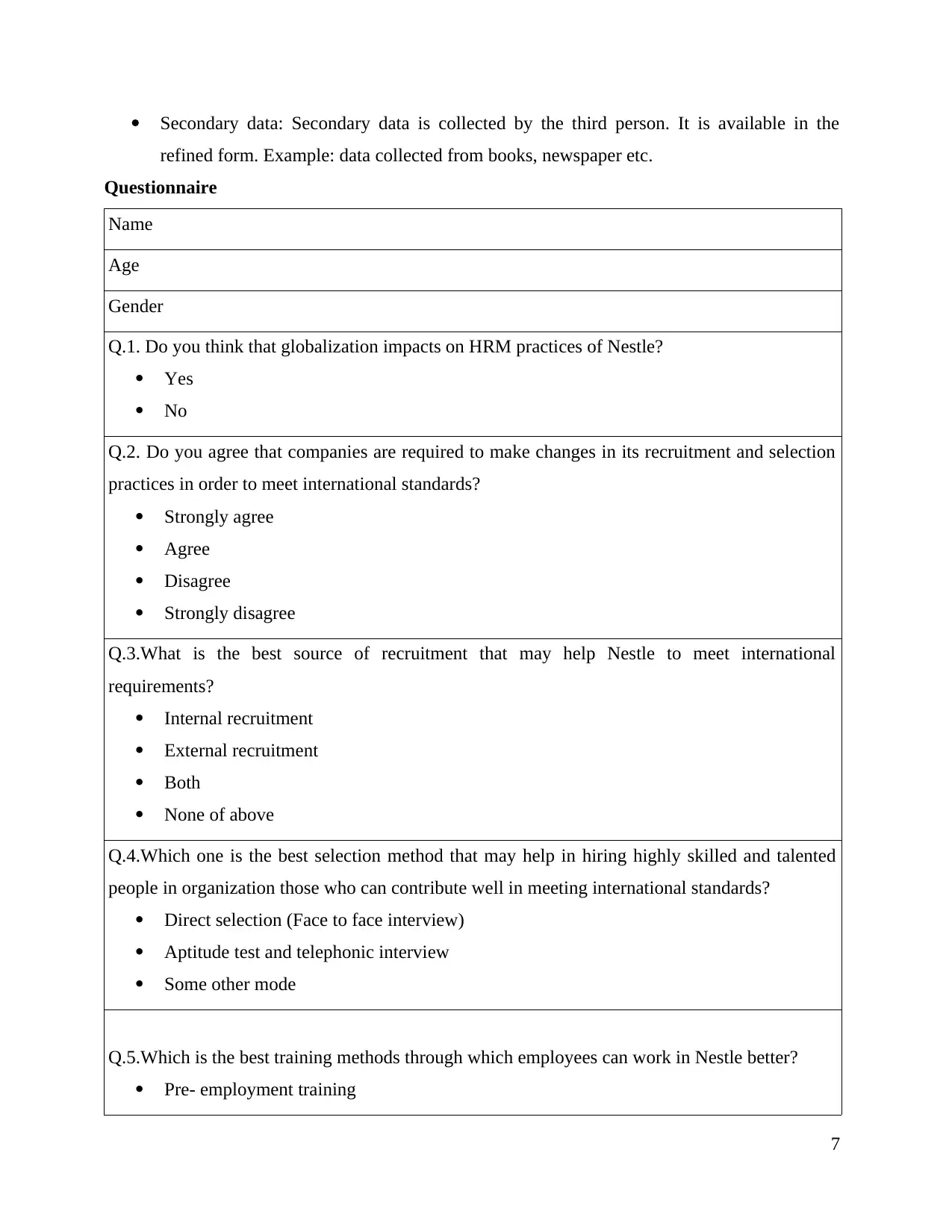
Secondary data: Secondary data is collected by the third person. It is available in the
refined form. Example: data collected from books, newspaper etc.
Questionnaire
Name
Age
Gender
Q.1. Do you think that globalization impacts on HRM practices of Nestle?
Yes
No
Q.2. Do you agree that companies are required to make changes in its recruitment and selection
practices in order to meet international standards?
Strongly agree
Agree
Disagree
Strongly disagree
Q.3.What is the best source of recruitment that may help Nestle to meet international
requirements?
Internal recruitment
External recruitment
Both
None of above
Q.4.Which one is the best selection method that may help in hiring highly skilled and talented
people in organization those who can contribute well in meeting international standards?
Direct selection (Face to face interview)
Aptitude test and telephonic interview
Some other mode
Q.5.Which is the best training methods through which employees can work in Nestle better?
Pre- employment training
7
refined form. Example: data collected from books, newspaper etc.
Questionnaire
Name
Age
Gender
Q.1. Do you think that globalization impacts on HRM practices of Nestle?
Yes
No
Q.2. Do you agree that companies are required to make changes in its recruitment and selection
practices in order to meet international standards?
Strongly agree
Agree
Disagree
Strongly disagree
Q.3.What is the best source of recruitment that may help Nestle to meet international
requirements?
Internal recruitment
External recruitment
Both
None of above
Q.4.Which one is the best selection method that may help in hiring highly skilled and talented
people in organization those who can contribute well in meeting international standards?
Direct selection (Face to face interview)
Aptitude test and telephonic interview
Some other mode
Q.5.Which is the best training methods through which employees can work in Nestle better?
Pre- employment training
7
⊘ This is a preview!⊘
Do you want full access?
Subscribe today to unlock all pages.

Trusted by 1+ million students worldwide
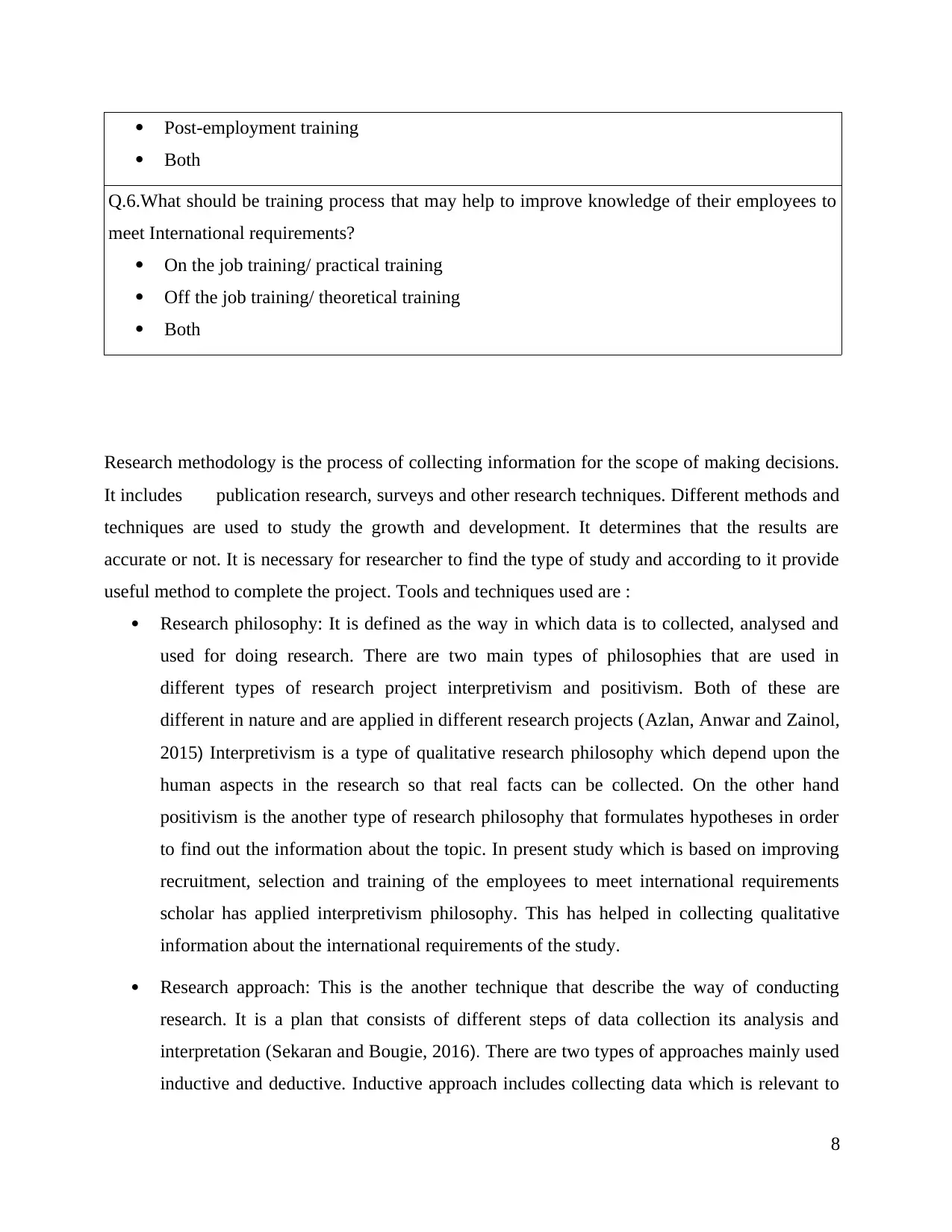
Post-employment training
Both
Q.6.What should be training process that may help to improve knowledge of their employees to
meet International requirements?
On the job training/ practical training
Off the job training/ theoretical training
Both
Research methodology is the process of collecting information for the scope of making decisions.
It includes publication research, surveys and other research techniques. Different methods and
techniques are used to study the growth and development. It determines that the results are
accurate or not. It is necessary for researcher to find the type of study and according to it provide
useful method to complete the project. Tools and techniques used are :
Research philosophy: It is defined as the way in which data is to collected, analysed and
used for doing research. There are two main types of philosophies that are used in
different types of research project interpretivism and positivism. Both of these are
different in nature and are applied in different research projects (Azlan, Anwar and Zainol,
2015) Interpretivism is a type of qualitative research philosophy which depend upon the
human aspects in the research so that real facts can be collected. On the other hand
positivism is the another type of research philosophy that formulates hypotheses in order
to find out the information about the topic. In present study which is based on improving
recruitment, selection and training of the employees to meet international requirements
scholar has applied interpretivism philosophy. This has helped in collecting qualitative
information about the international requirements of the study.
Research approach: This is the another technique that describe the way of conducting
research. It is a plan that consists of different steps of data collection its analysis and
interpretation (Sekaran and Bougie, 2016). There are two types of approaches mainly used
inductive and deductive. Inductive approach includes collecting data which is relevant to
8
Both
Q.6.What should be training process that may help to improve knowledge of their employees to
meet International requirements?
On the job training/ practical training
Off the job training/ theoretical training
Both
Research methodology is the process of collecting information for the scope of making decisions.
It includes publication research, surveys and other research techniques. Different methods and
techniques are used to study the growth and development. It determines that the results are
accurate or not. It is necessary for researcher to find the type of study and according to it provide
useful method to complete the project. Tools and techniques used are :
Research philosophy: It is defined as the way in which data is to collected, analysed and
used for doing research. There are two main types of philosophies that are used in
different types of research project interpretivism and positivism. Both of these are
different in nature and are applied in different research projects (Azlan, Anwar and Zainol,
2015) Interpretivism is a type of qualitative research philosophy which depend upon the
human aspects in the research so that real facts can be collected. On the other hand
positivism is the another type of research philosophy that formulates hypotheses in order
to find out the information about the topic. In present study which is based on improving
recruitment, selection and training of the employees to meet international requirements
scholar has applied interpretivism philosophy. This has helped in collecting qualitative
information about the international requirements of the study.
Research approach: This is the another technique that describe the way of conducting
research. It is a plan that consists of different steps of data collection its analysis and
interpretation (Sekaran and Bougie, 2016). There are two types of approaches mainly used
inductive and deductive. Inductive approach includes collecting data which is relevant to
8
Paraphrase This Document
Need a fresh take? Get an instant paraphrase of this document with our AI Paraphraser
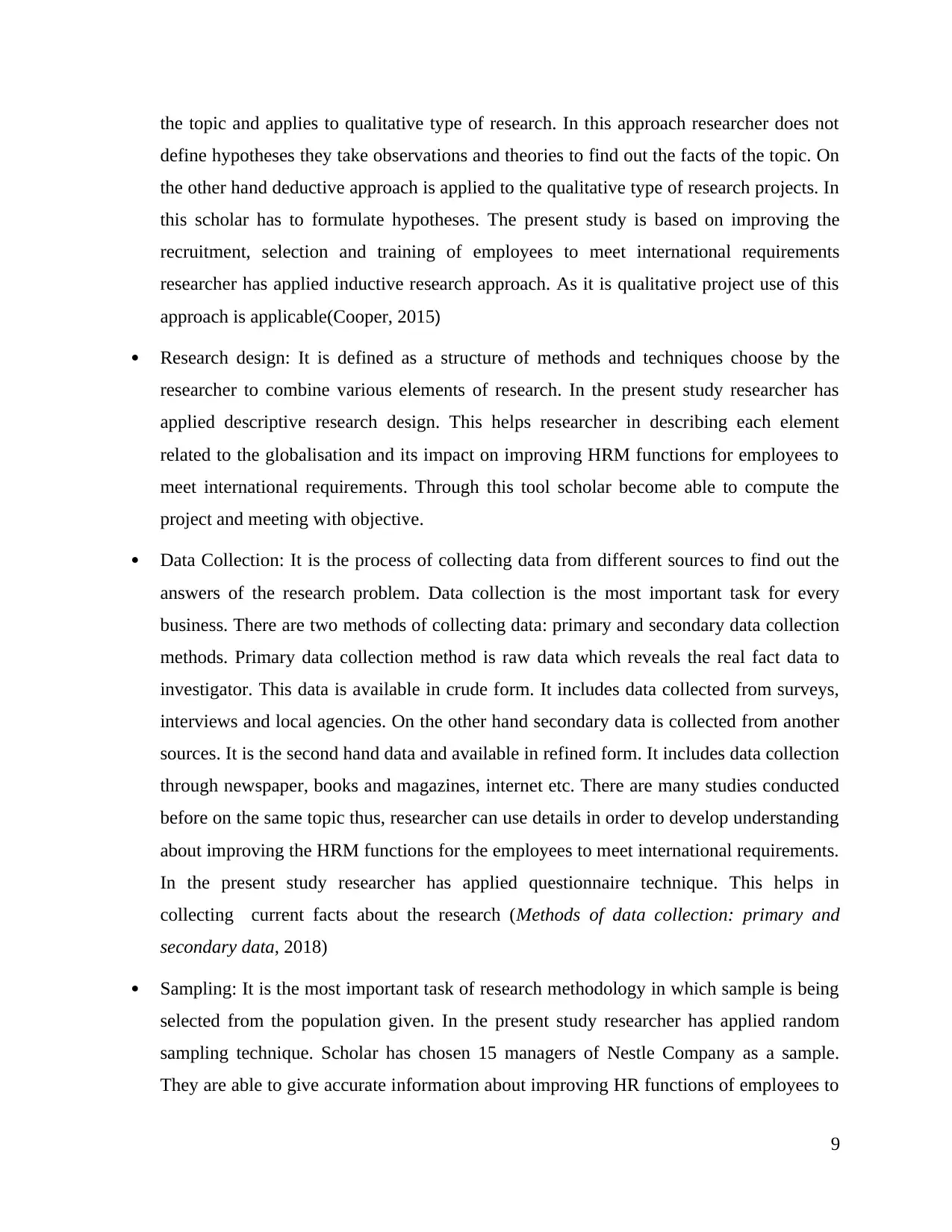
the topic and applies to qualitative type of research. In this approach researcher does not
define hypotheses they take observations and theories to find out the facts of the topic. On
the other hand deductive approach is applied to the qualitative type of research projects. In
this scholar has to formulate hypotheses. The present study is based on improving the
recruitment, selection and training of employees to meet international requirements
researcher has applied inductive research approach. As it is qualitative project use of this
approach is applicable(Cooper, 2015)
Research design: It is defined as a structure of methods and techniques choose by the
researcher to combine various elements of research. In the present study researcher has
applied descriptive research design. This helps researcher in describing each element
related to the globalisation and its impact on improving HRM functions for employees to
meet international requirements. Through this tool scholar become able to compute the
project and meeting with objective.
Data Collection: It is the process of collecting data from different sources to find out the
answers of the research problem. Data collection is the most important task for every
business. There are two methods of collecting data: primary and secondary data collection
methods. Primary data collection method is raw data which reveals the real fact data to
investigator. This data is available in crude form. It includes data collected from surveys,
interviews and local agencies. On the other hand secondary data is collected from another
sources. It is the second hand data and available in refined form. It includes data collection
through newspaper, books and magazines, internet etc. There are many studies conducted
before on the same topic thus, researcher can use details in order to develop understanding
about improving the HRM functions for the employees to meet international requirements.
In the present study researcher has applied questionnaire technique. This helps in
collecting current facts about the research (Methods of data collection: primary and
secondary data, 2018)
Sampling: It is the most important task of research methodology in which sample is being
selected from the population given. In the present study researcher has applied random
sampling technique. Scholar has chosen 15 managers of Nestle Company as a sample.
They are able to give accurate information about improving HR functions of employees to
9
define hypotheses they take observations and theories to find out the facts of the topic. On
the other hand deductive approach is applied to the qualitative type of research projects. In
this scholar has to formulate hypotheses. The present study is based on improving the
recruitment, selection and training of employees to meet international requirements
researcher has applied inductive research approach. As it is qualitative project use of this
approach is applicable(Cooper, 2015)
Research design: It is defined as a structure of methods and techniques choose by the
researcher to combine various elements of research. In the present study researcher has
applied descriptive research design. This helps researcher in describing each element
related to the globalisation and its impact on improving HRM functions for employees to
meet international requirements. Through this tool scholar become able to compute the
project and meeting with objective.
Data Collection: It is the process of collecting data from different sources to find out the
answers of the research problem. Data collection is the most important task for every
business. There are two methods of collecting data: primary and secondary data collection
methods. Primary data collection method is raw data which reveals the real fact data to
investigator. This data is available in crude form. It includes data collected from surveys,
interviews and local agencies. On the other hand secondary data is collected from another
sources. It is the second hand data and available in refined form. It includes data collection
through newspaper, books and magazines, internet etc. There are many studies conducted
before on the same topic thus, researcher can use details in order to develop understanding
about improving the HRM functions for the employees to meet international requirements.
In the present study researcher has applied questionnaire technique. This helps in
collecting current facts about the research (Methods of data collection: primary and
secondary data, 2018)
Sampling: It is the most important task of research methodology in which sample is being
selected from the population given. In the present study researcher has applied random
sampling technique. Scholar has chosen 15 managers of Nestle Company as a sample.
They are able to give accurate information about improving HR functions of employees to
9
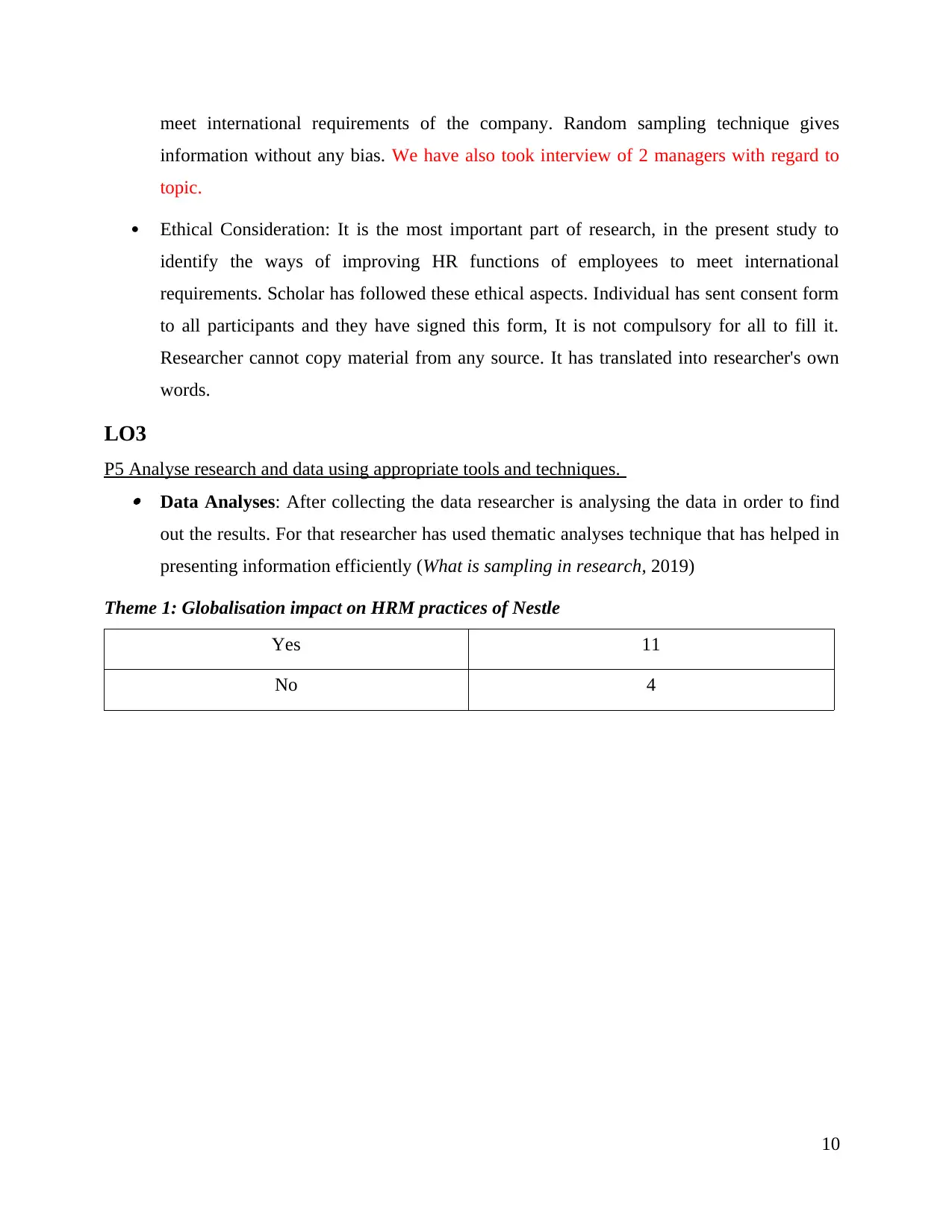
meet international requirements of the company. Random sampling technique gives
information without any bias. We have also took interview of 2 managers with regard to
topic.
Ethical Consideration: It is the most important part of research, in the present study to
identify the ways of improving HR functions of employees to meet international
requirements. Scholar has followed these ethical aspects. Individual has sent consent form
to all participants and they have signed this form, It is not compulsory for all to fill it.
Researcher cannot copy material from any source. It has translated into researcher's own
words.
LO3
P5 Analyse research and data using appropriate tools and techniques. Data Analyses: After collecting the data researcher is analysing the data in order to find
out the results. For that researcher has used thematic analyses technique that has helped in
presenting information efficiently (What is sampling in research, 2019)
Theme 1: Globalisation impact on HRM practices of Nestle
Yes 11
No 4
10
information without any bias. We have also took interview of 2 managers with regard to
topic.
Ethical Consideration: It is the most important part of research, in the present study to
identify the ways of improving HR functions of employees to meet international
requirements. Scholar has followed these ethical aspects. Individual has sent consent form
to all participants and they have signed this form, It is not compulsory for all to fill it.
Researcher cannot copy material from any source. It has translated into researcher's own
words.
LO3
P5 Analyse research and data using appropriate tools and techniques. Data Analyses: After collecting the data researcher is analysing the data in order to find
out the results. For that researcher has used thematic analyses technique that has helped in
presenting information efficiently (What is sampling in research, 2019)
Theme 1: Globalisation impact on HRM practices of Nestle
Yes 11
No 4
10
⊘ This is a preview!⊘
Do you want full access?
Subscribe today to unlock all pages.

Trusted by 1+ million students worldwide
1 out of 24
Related Documents
Your All-in-One AI-Powered Toolkit for Academic Success.
+13062052269
info@desklib.com
Available 24*7 on WhatsApp / Email
![[object Object]](/_next/static/media/star-bottom.7253800d.svg)
Unlock your academic potential
Copyright © 2020–2025 A2Z Services. All Rights Reserved. Developed and managed by ZUCOL.





